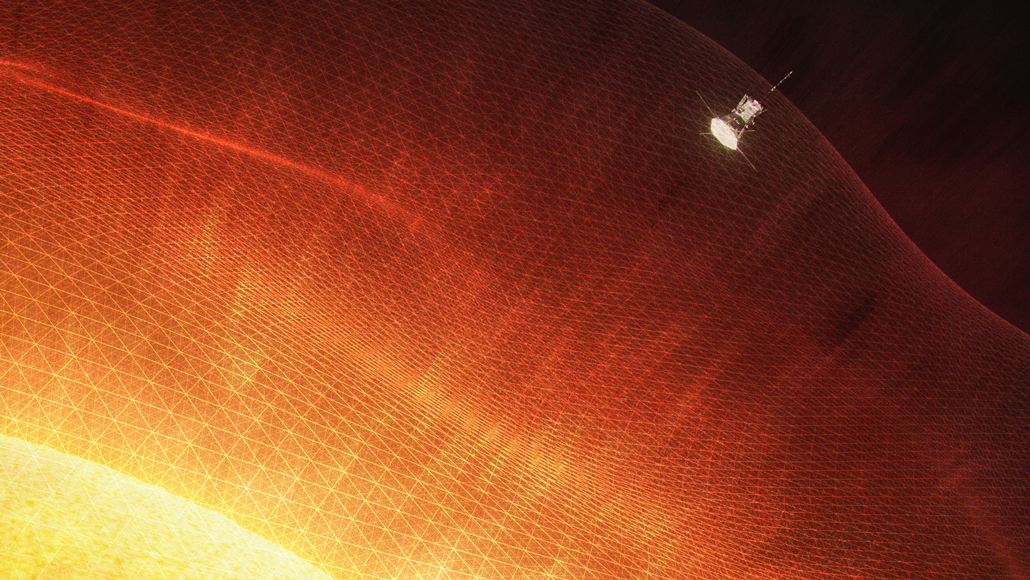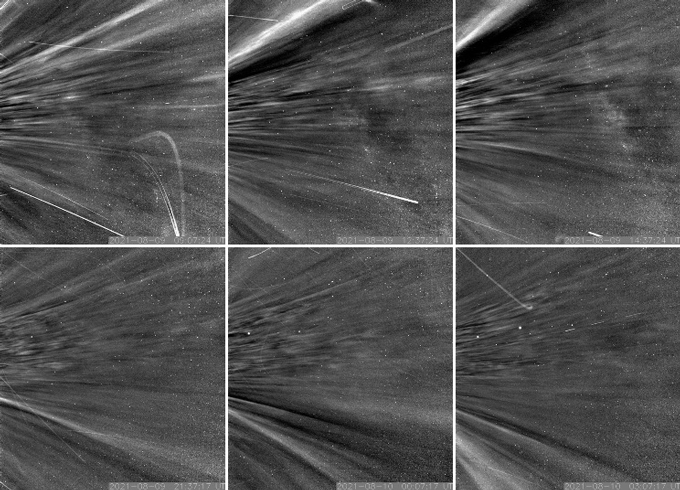
NASA’s Parker Solar Probe (upper right in this illustration) has dipped below the crucial layer that separates the sun’s atmosphere from the rest of space. The solar atmosphere, or corona, is depicted here as a wavy red grid.
Joy Ng, NASA's Goddard Space Flight Center
- More than 2 years ago
For the first time, a spacecraft has made contact with the sun. During a recent flyby, NASA’s Parker Solar Probe entered the sun’s atmosphere.
“We have finally arrived,” Nicola Fox, director of NASA’s Heliophysics Science Division in Washington, D.C., said December 14 in a news briefing at the fall meeting of the American Geophysical Union. “Humanity has touched the sun.”
Parker left interplanetary space and crossed into solar territory on April 28, 2021, during one of its close encounters with the sun. While there, the probe took the first measurements of exactly where this boundary, called the Alfvén critical surface, lies. It was about 13 million kilometers above the sun’s surface, physicists reported at the meeting, held online and in New Orleans, and in Physical Review Letters on December 14.
“We knew the Alfvén critical surface had to exist,” solar physicist Justin Kasper of the University of Michigan in Ann Arbor said at the news briefing. “We just didn’t know where it was.”
Finding this crucial layer was one of Parker’s main goals when it launched in 2018 (SN: 7/5/18). The Alfvén critical surface is important because it marks where packets of plasma can separate from the sun and become part of the solar wind, the speedy stream of charged particles that constantly emanates from the sun (SN: 8/18/17). The solar wind and other, more dramatic forms of space weather can wreak havoc on Earth’s satellites and even on life (SN: 2/26/21). Scientists want to pinpoint exactly how the wind gets started to better understand how it can impact Earth.
The Alfvén critical surface also may hold the key to one of the biggest solar mysteries: why the sun’s corona, its wispy outer atmosphere, is so much hotter than the sun’s surface (SN: 8/20/17). With most heat sources, temperatures drop as you move farther away. But the sun’s corona sizzles at more than a million degrees Celsius, while the surface is only a few thousand degrees.
In 1942, physicist Hannes Alfvén proposed a solution to the mystery: A type of magnetic wave might carry energy from the solar surface and heat up the corona. It took until 2009 to directly observe such waves, in the lower corona, but they didn’t carry enough energy there to explain all the heat (SN: 3/19/09). Solar physicists have suspected that what happens as those waves climb higher and meet the Alfvén critical surface might play a role in heating the corona. But until now, scientists didn’t know where this frontier began.
With the boundary identified, “we’ll now be able to witness directly how coronal heating happens,” Kasper said.
As Parker crossed the invisible boundary, its instruments recorded a marked increase in the strength of the local magnetic field and a drop in the density of charged material. Out in the solar wind, waves of charged particles gush away from the sun. But below the Alfvén critical surface, some of those waves bend back toward the surface of the sun.

Surprisingly, Parker’s measurements showed that the Alfvén critical surface is wrinkly. “That was one of the big outstanding questions,” says solar physicist Craig DeForest of the Southwest Research Institute in Boulder, Colo., who is a member of the Parker probe team but was not part of this measurement.
“There was some debate in the community about whether the Alfvén surface would exist as a surface at all,” he says. Decades ago, scientists imagined the boundary as a smooth sphere surrounding the sun like a snow globe. More recently, some thought it would be so ragged that it wouldn’t be apparent when the spacecraft crossed it.
Neither of those images turned out to be correct. The surface is smooth enough that the moment of crossing was noticeable, Kasper said. But during the spacecraft’s close approach to the sun in April, it crossed in and out of the boundary three times. The first dip lasted about five hours, the last only half an hour.
“The surface clearly has some structure and warp to it,” Kasper said.
That structure could influence everything from the way solar eruptions leave the sun to the way the solar wind interacts with itself farther out from the sun, DeForest says. “That has consequences that we don’t know yet, but are likely to be profound,” he says. “This is very exciting. It’s terra incognita.”
Parker is still orbiting the sun and planning to make several more close approaches over the next few years, eventually getting within 6 million kilometers of the solar surface. That should bring Parker into the solar corona again and again, solar physicist Nour Raouafi of the Johns Hopkins Applied Physics Laboratory in Laurel, Md., said in the news briefing. The spacecraft may have made another journey past the Alfvén critical surface in August and will have another opportunity in January.
“The expectation is that as we fly closer and closer to the sun, we’ll keep crossing this boundary,” Raouafi said. But the boundary might not be in the same place every time. As the sun’s activity changes, the level of the Alfvén critical surface is expected to rise and fall as if the corona is breathing in and out, he said.
That’s another thing that scientists hope to observe for the first time.







